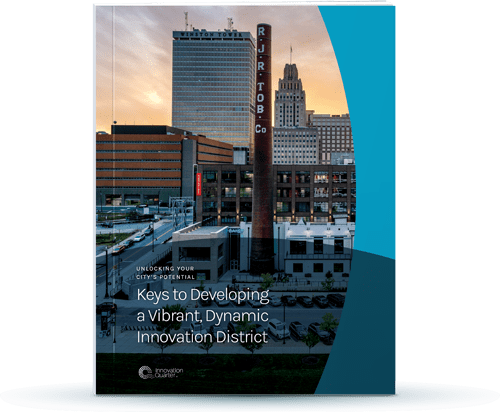Innovation districts are popping up across the world, dismantling the norms of the workaday world and breathing new life into under-performing spaces. However, many underestimate what goes into establishing one that can drive such transformative disruption. It isn’t just about reinventing shared physical spaces—it’s about creating intimate connections between people and companies. Intentional planning, placemaking and programming are our top three innovation district best practices.
Planning
Community Input is Integral to a Healthy Innovation District
Innovation districts cannot thrive on top-down strategies. They require a mission that is anchored in the community, engages a diverse range of people and provides opportunities for workers of all skill and education levels. This kind of equitable environment can only be achieved through listening to the voices of the community and developing a strategy based on grassroots needs of (but not limited to) people of color, women and the LGBTQ+ community.

Planning is a critical phase—and innovation district best practice—when partners are assessed and goals are identified, but it’s also an important starting point in developing a strong relationship with the community. Many districts emerge from or near underserved and low-income neighborhoods and have the potential to be a catalyst for change within those areas. Engaging the community not only increases chances of buy-in and support, but it also provides stakeholders with a perspective that’s crucial to development. Community members can best articulate what issues plague the area and the resources that would be most meaningful to the population.
The Innovation Quarter’s ongoing partnerships with organizations like HUSTLE W-S and Soy Emprendedor are emblematic of its commitment to making sure everyone has a seat at the table, and that everyone has a say at that table.
Placemaking
Creating an Emotional Connection Between Physical Spaces and the Community
Placemaking is both a philosophy and a process: It stems from a vision to create spaces that contribute to people’s health, happiness and well-being and manifests itself as re-imagined everyday spaces, like parks, downtowns, streets and public plazas.
Innovation districts blur the lines between public and private, living and working and academic and corporate spaces. The fluidity of space nurtures a convivial spirit that permeates throughout the community and becomes part of its identity. Placemaking is one of the innovation district best practices that has the power to affect quality-of-life measures, including:
- Sociability: volunteerism, evening use and strength of social networks
- Accessibility: transit usage and walkability
- Usability: local business ownership, property values and rent levels
- Livability: crime statistics and sanitation ratings
There’s a strategic reason why Bailey Park sits in the center of the Innovation Quarter. That land could have easily been used to erect another building or parking deck. But the variety of connections and vibrancy that the park brings to the district is crucial to creating a sense of place.




Programming
Activating Spaces within an Innovation District
Programming is a fundamental aspect of placemaking and is vital to the success of an innovation district. Simply creating the space and making it accessible is not enough of a reason for people to come. Programming encourages participation from people of all ages, abilities and socioeconomic backgrounds while also serving as a community resource.
Facilitating social connections through programming—activities that teach skills, strengthen connections and build networks—is the most effective pathway to building a healthy innovation district. Inclusive and authentic programming has become the lifeblood of the Innovation Quarter, encouraging bonds that are vital to innovation and social justice. Some examples include:
- The SciTech Institute, a program that gives middle school students exposure to careers in STEM through partnerships with local companies and organizations. Through hands-on and experiential learning, SciTech helps students develop practical skills to further explore STEM-related careers.
- Innovation & Cinema, a free outdoor movie-screening event. Locals from area institutions give brief pre-film talks and relate their work or expertise to the film, jump starting conversations about how the films reflect the various ways innovation, science and technology impact everyday lives.




Innovation District Best Practices to Leverage for a Vibrant, Community Space
In addition to providing spaces that people want to share with each other, the Innovation Quarter has made conscious efforts to elevate community perspectives and provide opportunities to nurture undiscovered skills. The combination of our top three innovation district best practices—planning, placemaking and programming—creates a vibrant atmosphere where relationships, connections and potential can flourish.




